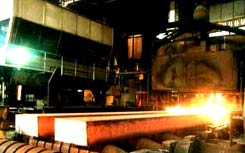Now, US steel industry asks for government bailout
02 Jan 2009
After the auto industry bailout announced by the Bush administration in its last days, even the American steel industry is looking for similar support from the government. An amount of $1 trillion over two years is being eyed to hike demand for steel for use in roads, bridges, electric power grids, universities, medical centres, water treatment facilities and mass transit system.
''What we are asking,'' said Daniel R DiMicco, chairman and CEO of the Nucor Corporation, a giant steel maker, ''is that our government deal with the worst economic slowdown in our lifetime through a recovery programme that has in every provision a 'buy America' clause.''
 Economists in US President-elect Obama's camp said his proposals to the US Congress would include significant infrastructure spending that draws on heavy industry. "We are sharing with the president-elect's transition team our thoughts in terms of the industry's policy priorities," Nancy Gravatt, a spokeswoman for the American Iron and Steel Institute, was quoted as saying.
Economists in US President-elect Obama's camp said his proposals to the US Congress would include significant infrastructure spending that draws on heavy industry. "We are sharing with the president-elect's transition team our thoughts in terms of the industry's policy priorities," Nancy Gravatt, a spokeswoman for the American Iron and Steel Institute, was quoted as saying.
Until July, the US steel industry was enjoying a boom, fuelled by the high demand for steel in China that led to unprecedented profit levels for steel companies. As a result shares of US Steel traded almost $192 a stock, while that of Nucor peaked at a 52-week high of $83.56 in May.
However, by August, orders for steel products from China, North America and Europe started to subside causing prices of some steel product to decrease by up to 40 per cent, while shares of US Steel plummeted 68 per cent.
By mid-December domestic raw steel production was down 44 per cent compared to 2007 figure, while steel mills operated at slightly less than 50 per cent of their capacities, according to the American Iron and Steel Institute. (See: Steel slowdown: Chronology of production cuts)
The cutback has been particularly hard on workers at the big integrated mills like those at US Steel and Arcelor Mittal USA, with their blast furnaces and coke ovens converting iron ore and other materials into steel. Operated at less than full capacity, these mills are less efficient than the equally large ''minimills,'' like Nucor, whose electric arc furnaces can be operated efficiently at lower speeds. (See: Slowdown forces ArcelorMittal to cut output by up to 35 per cent / Corus raises production cuts to 30 per cent; axes 400 jobs)
So the plant closings have been mostly at the integrated mills, whose 50,000 workers - roughly 40 per cent of the nation's steelworkers - are represented by the United Steelworkers. The union says that early this year it expects 20,000 workers to be on furlough, of which half have already been affected. (See: ArcelorMittal to lay-off 16 per cent of US workers)






















